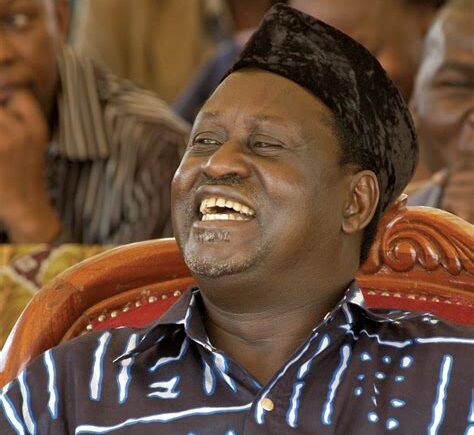2007: The Stolen Election and Kenya’s Darkest Hour
The 2007 presidential election was Raila Odinga’s finest campaign and Kenya’s greatest electoral tragedy. Running under the Orange Democratic Movement (ODM) banner against incumbent President Mwai Kibaki, Raila assembled a formidable coalition that transcended ethnic boundaries. He united the Luo, Luhya, Kalenjin, and Coastal communities in an unprecedented political alliance. His running mate was Musalia Mudavadi, and his campaign team included luminaries like William Ruto and Najib Balala.
Opinion polls throughout the campaign placed Raila firmly ahead. By late October 2007, he commanded 50% support against Kibaki’s 39%. Even as the race tightened in November, Raila maintained his lead. His rallies drew massive, euphoric crowds across Kenya. The nation was ready for change. After Kibaki’s first term had been marred by corruption scandals and broken promises, Kenyans needed change.
On December 27, 2007, Kenyans voted in record numbers. As results began trickling in on December 28, Raila held a commanding lead. Early tallies from 69 of 210 constituencies showed Odinga with 1,691,679 votes against Kibaki’s 1,222,725. The ODM declared victory on December 29. International observers and local monitors confirmed Raila’s strong lead. Even the Electoral Commission of Kenya’s own stream of results showed Raila ahead by thousands of votes as counting continued.
Then something inexplicable happened.
On the morning of December 30, with nearly 90% of votes counted, Raila’s substantial lead had mysteriously shrunk to just 38,000 votes. Results from Kibaki’s Central Kenya strongholds were being announced with figures that defied logic—some constituencies reported turnout rates exceeding 100%. The tallying process, which had been proceeding smoothly, suddenly slowed to a crawl. The Electoral Commission stopped publicly announcing results. Confusion reigned.
At a press conference that morning, Raila accused the government of massive fraud. He urged Kibaki to concede defeat and called for an immediate recount. He warned that Kenya stood on the brink of chaos.
Later that same day, December 30, 2007, the Electoral Commission of Kenya abruptly declared Kibaki the winner by approximately 232,000 votes, placing him at 46% against Raila’s 44%. It was the narrowest margin in Kenya’s history, yet no recount was ordered despite glaring irregularities. Within minutes of the announcement, riot police surrounded the Electoral Commission offices. All live television broadcasts were yanked off the air. And in a bizarre dusk ceremony conducted in the State House gardens, not in public view, Mwai Kibaki was hastily sworn in for a second term.
Kenya exploded.
Post-Election Violence: A Nation on the Brink
What followed were the darkest three months in Kenya’s post-independence history. Convinced that their votes had been stolen, Raila’s supporters, particularly in Nyanza, Western Kenya, the Rift Valley, and Nairobi’s slums, took to the streets in fury.
The violence was horrifying. In Eldoret, a church where Kikuyu families had sought refuge was set ablaze, killing dozens. In Naivasha and Nakuru, revenge killings claimed hundreds of lives. Nairobi’s Kibera slum became a battleground. Machetes, arrows, and crude weapons turned neighbors into enemies. Police shot protesters in the streets. Entire communities were burned to the ground.
By the time the violence subsided in late February 2008, over 1,300 Kenyans were dead. More than 600,000 people, some estimates say closer to a million, had been displaced from their homes. Thousands bore physical scars from machete wounds, beatings, and burns. The psychological trauma would last for generations. Kenya, once hailed as East Africa’s beacon of stability, had nearly collapsed into civil war.
International observers were unequivocal in their assessment. The European Union declared the election “flawed.” The head of the Electoral Commission himself, Samuel Kivuitu, later admitted in testimony before the Kriegler Commission that he did not know who had actually won the election. A U.S.-commissioned exit poll, released in July 2008, showed Raila had won by a comfortable margin of 46% to 40% well outside the poll’s margin of error. Royal Media Services owner SK Macharia later testified before a Senate committee that his media house had conducted parallel tallying using satellite technology, and their results showed Raila as the clear winner.
The evidence was overwhelming: the 2007 election had been stolen from Raila Odinga.
The Grand Coalition: Choosing Peace Over Power
Even as Kenya burned and his supporters demanded that he be declared president, Raila Odinga made a choice that would define his legacy. He could have held firm, refusing any compromise, potentially plunging Kenya into full-scale civil war. He could have accepted Kibaki’s offer of a ministerial position, as he had done with Moi years earlier. Instead, he chose a third path, one that would save Kenya but deny him the presidency he had rightfully won.
Former United Nations Secretary-General Kofi Annan arrived in Kenya to mediate between the two camps. The African Union sent Ghana’s President John Kufuor. Week after week, tense negotiations took place at the Serena Hotel in Nairobi, with Annan shuttling between Kibaki and Raila, trying to find common ground. Kibaki’s side initially resisted, insisting he was the legitimate president. The ODM demanded a recount or fresh elections. The country waited, traumatized and exhausted.
Finally, on February 28, 2008, after 41 days of mediation, an agreement was reached. Kibaki would remain as President, but a new position of Prime Minister would be created with executive authority. Raila would become Kenya’s first Prime Minister in a Grand Coalition Government. Cabinet positions would be shared equally between PNU and ODM. An independent commission would investigate the electoral fraud. Constitutional and institutional reforms would be prioritized.
It was not what Raila wanted. It was not what his millions of supporters had voted for. But it was what Kenya needed.
On April 17, 2008, Raila Odinga was sworn in as Prime Minister. At the ceremony, he and Kibaki shook hands before a traumatized nation desperate for reconciliation.
The Grand Coalition Government was unwieldy, with 94 cabinet ministers and assistant ministers, it was bloated and often dysfunctional. But it worked. The violence stopped. Internally displaced persons began returning home.
As Prime Minister from 2008 to 2013, Raila worked alongside his rival to restore stability, push through the new 2010 Constitution, and rebuild Kenya. But the bitterness of 2007 never fully left him. Raila had won the presidency, but it had been stolen. He had sacrificed his victory for Kenya’s survival.
Note:
-
Raila Odinga was not implicated, nor formally charged by the International Criminal Court (ICC) or any Kenyan court in relation to the violence.
-
The ICC investigation (launched in 2010) focused on six individuals — including William Ruto, Uhuru Kenyatta, and others — but not Raila Odinga.
-
The Waki Commission Report (2008), which investigated the violence, did not name Odinga as responsible for organizing or directing attacks, though it noted that some ODM (Orange Democratic Movement) supporters were involved in retaliatory violence in certain regions.
-
Raila consistently urged for peace and called for mediation during the crisis.
Published by the Luo National Congress
October 17, 2025

